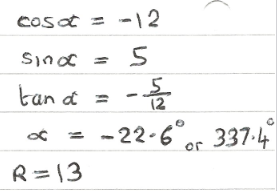I am still confused here to be honest. How can we solve this equation using the alternative form of Rcos(A+B) instead?
I know how to solve the equation using the form Rsin(A-B) but I just want to know why it's not working using the alternative form?
When I try and use this form, I end up with RcosB = -12 and RsinB = -5 giving A as 22.6 degrees.
Now solving gives: 13cos(A + 22.6) = 6
Producing angles of 39.9 and 274.9 degrees.
These are obviously wrong answers but why? If I wanted to use the form Rcos(A+B) what signs would need to be on sinB and cosB to match it up ?

